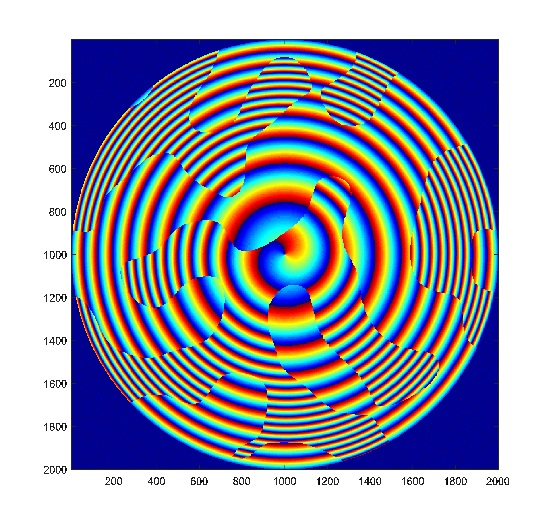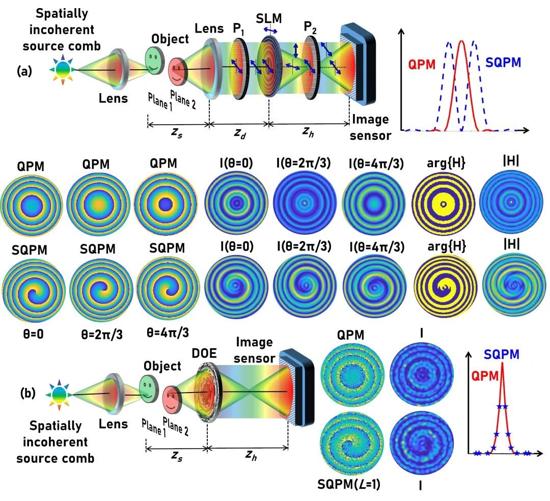The quest for developing novel imaging technologies to observe objects with high resolution is on-going. One of the straight-forward resolution enhancement technologies include illuminating objects with electromagnetic radiation with wavelengths shorter than that of the visible light which led to the development of electron, X-ray and ion microscopes, etc. An alternative method to improve the resolving power is to increase the numerical aperture of the imager. Both approaches have different types of technological demands; the former requires a compatible source, lens, and detector for a different electromagnetic spectral range, the later requires manufacturing of lenses with larger diameters or changes in optical configuration that still affect the modulation transfer function in a similar fashion. The above methodologies impose challenging loads on both the fabrication and materials engineering fronts. One of the easiest methods to improve the imaging resolution is to replace a coherent illumination with an incoherent one, which in turn doubles the spatial frequency limits of imaging. In addition to resolution enhancement, the above method also brings various advantages such as formation of images without speckles or edge ringing and at a substantially lower cost.
A classical incoherent imaging system has twice the bandwidth of an equivalent coherent imaging system, but has a non-uniform response to different spatial frequencies. The higher spatial frequencies endure a stronger attenuation than the lower spatial frequencies and so the full potential of the doubling bandwidth is not translated to the maximum possible resolution. In 2007, a non-classical imaging technique capable of breaking the Lagrange Invariant condition was developed by two eminent scientists namely Prof. Joseph Rosen, Ben Gurion University and Prof. Gary Brooker, John Hopkins University, with capabilities for a uniform response over the entire bandwidth. This super resolution technique is called Fresnel incoherent correlation holography (FINCH). In FINCH, the two-point resolution is unique, originating from the fact that when two points are imaged, the magnification of the spacing between the points is higher than the magnification of a point, an advantageous abnormality that results in a super-resolution. FINCH has disadvantages however, such as lower axial and time resolutions.

Optical configuration of FINCH with (a) polarization multiplexing and (b) spatial multiplexing.
While there are numerous researchers that developed technologies to improve the time resolution, all such research were only focused on converting the required temporal shots into spatially or polarization multiplexed single shot. As a consequence, the temporal resolution was increased at the cost of either the field of view or signal to noise ratio. In all the previous studies, the inline FINCH hologram was reconstructed by a Fresnel back propagation which generated the twin images and bias terms. At least three camera shots with relative phase-shifts were needed to synthesize a complex hologram which, when reconstructed by Fresnel propagation, generates the image without the twin image and bias terms. A game changing approach to FINCH was introduced by the Swinburne's nanotechnology and nanophotonics research team in 2020, in which a modified reconstruction mechanism was applied which simultaneously increased the temporal as well as axial resolution. In this study, the point spread function of FINCH is recorded and is used as the reconstructing function with a cross-correlation by a non-linear filter. Thus, the problem was converted into a pattern recognition problem. The FINCH system was realized using a spatially random multiplexed single diffractive optical element fabricated using electron beam lithography. The above procedure resulted in a compact, light-weight version of FINCH with a single camera shot and improved axial resolution.

Phase image of a diffractive optical element formed by randomly multiplexing a quadratic phase mask and a spiral quadratic phase mask with a scattering ratio of 0.02.
The Swinburne's nanotechnology and nanophotonics research team has recently investigated a fundamental problem, the transfer of characteristics from modulation function to the reconstructed image in FINCH, with two types of numerical reconstructions: Fresnel propagation and non-linear correlation in both spatial as well as polarization multiplexing modes. The results of the study are published in Chinese Optics Letters, Volume 19, No. 2, 2021 (V. Anand, et al., Review of Fresnel incoherent correlation holography with linear and non-linear correlations [Invited]). The investigation revealed interesting characteristics of FINCH in non-linear correlation mode. FINCH in Fresnel propagation mode faithfully transfers the characteristics of the modulation function to the reconstructed image. FINCH in non-linear correlation mode offers a platform to manipulate the degree by which the beam characteristics are transferred to the reconstructed image by controlling the degree of chaos in the spatially multiplexed diffractive element. Consequently, the above mode of operation improves the tolerance of FINCH to noise and aberrations. The findings of the study are expected to not only open new pathways to introduce special imaging characteristics but also guide in building versatile FINCH scopes in the future.


